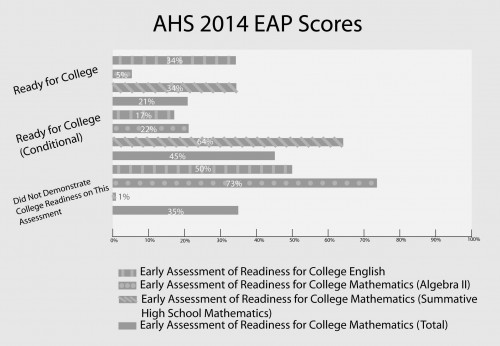AHS EAP 2014 Scores Indicate Lack of College Readiness

Editor in Chief
DENISE TIEU
News Editor
Near the end of the school year, students from second grade to eleventh grade are required to take the California Standards Test (CST). In regards to the CST administered for juniors, the standardized test includes the Early Assessment Program (EAP), an optional testing segment for Mathematics and English competency at the college level.
According to the California State University (CSU) website, an estimated 60 percent of students admitted into the CSU system, most of whom were among the top third of their year, were required to take remedial English and/or Mathematics courses. Remedial classes do not contribute to a degree and cost students around the nation $3 billion annually, according to the Huffington Post.
The EAP was created by the State Board of Education, the California Department of Education, the CSU system and California Community Colleges in order to promote the importance of CSTs and allow high school seniors to have an idea of how college-ready they are in order to improve upon their skills, as well as determine which students are exempt from taking CSU placement exams, as mentioned by the CSU website. The EAP includes both CSU’s placement standards and alignment with high school standards.
“A good amount of students did not take the EAP seriously, especially considering that students rarely take the CST seriously,” senior Monying Dominguez said.
Recently, Alhambra High School’s EAP 2014 results were released on the EAP website. Out of 638 students from the class of 2015, 398 took the EAP English portion, 187 took the EAP Algebra II portion and 215 took the Summative High School Mathematics portion. Fewer students took the exam in 2014 than in 2013 because the shift to Common Core meant that not all took the CST. However, according to the report, 50 percent of AHS students who took the English portion are not ready for college-level courses, while 73 percent of Algebra II and 1 percent of Summative High School Mathematics testers are not. Statewide, 61 percent of English test-takers and 49 percent of Mathematics test-takers did not demonstrate readiness for college in the 2014 results.
Additionally, 17 percent of English, 22 percent of Algebra II and 64 percent of Summative High School Mathematics testers are conditionally ready for college, meaning they must continue to work in senior year in order to be prepared. The CSU recommends that conditionally ready students enroll in an AP, Honors or International Baccalaureate English class and/or a math class with Algebra II as a prerequisite in senior year. Students received a letter stating whether they were ready, conditionally ready or not ready for college-level classes in the fall of senior year.
“I [thought] that the EAP was really tricky. I had a hard time figuring it out and I was surprised when I passed it. It was pretty difficult,” senior Vivian Chau said.
In the future, as California makes the transition from the CST to the Smarter Balanced Assessment Consortium (SBAC) test, the optional section may no longer be necessary, according to the CSU website. CSUs hope to be able to determine college readiness from the SBAC scores alone.
“I [do not] know any test that can truly measure college readiness […] That being said, students have clearly exhibited an inability to think and analyze,” Mathematics Department Chair Paul Stein said. “If students only learn material to ace a test, then they are not always making the connections they need to make. Students need to be responsible for how they study and try not to always take the easy way out. Rather than complain when things get difficult, try to collaborate and figure it out. This is how problem solving works in the real world.”